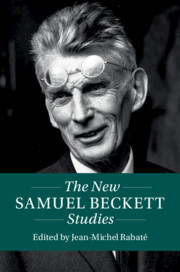Book contents
- The New Samuel Beckett Studies
- Twenty-First-Century Critical Revisions
- The New Samuel Beckett Studies
- Copyright page
- Contents
- Figures
- Contributors
- Editor’s Introduction
- I The Expanded Canon
- II New Contexts and Intertexts
- Chapter 5 Beckett’s Critique of Literature
- Chapter 6 Beckett, Political Memory, and the Sense of History
- Chapter 7 Samuel Beckett as Contemporary Artist
- Chapter 8 Beckett, Radio, and the Voice
- III New Hermeneutic Codes
- Index
Chapter 6 - Beckett, Political Memory, and the Sense of History
from II - New Contexts and Intertexts
Published online by Cambridge University Press: 17 June 2019
- The New Samuel Beckett Studies
- Twenty-First-Century Critical Revisions
- The New Samuel Beckett Studies
- Copyright page
- Contents
- Figures
- Contributors
- Editor’s Introduction
- I The Expanded Canon
- II New Contexts and Intertexts
- Chapter 5 Beckett’s Critique of Literature
- Chapter 6 Beckett, Political Memory, and the Sense of History
- Chapter 7 Samuel Beckett as Contemporary Artist
- Chapter 8 Beckett, Radio, and the Voice
- III New Hermeneutic Codes
- Index
Summary
In 1937, the young Beckett, freshly returned from Nazi Germany, conceded to Thomas MacGreevy that his friend had been right all along: the “sense of history” was precisely what he was sorely lacking. His letter affirms an absence of feeling for history, just as it summons the very phrase deployed by Hegel, Marx, and Nietzsche to represent the formation of modern nations and the human spirit. It is tempting to take Beckett’s comment as a declaration of cultivated ignorance: he has frequently been portrayed as a writer severed from the political concerns shared by his contemporaries, absorbed in a peculiar internal world of his own making. Yet, increasingly, the consensus around Beckett’s apparent insensitivity to history and politics does not accord with the wealth of evidence available.
- Type
- Chapter
- Information
- The New Samuel Beckett Studies , pp. 103 - 117Publisher: Cambridge University PressPrint publication year: 2019

